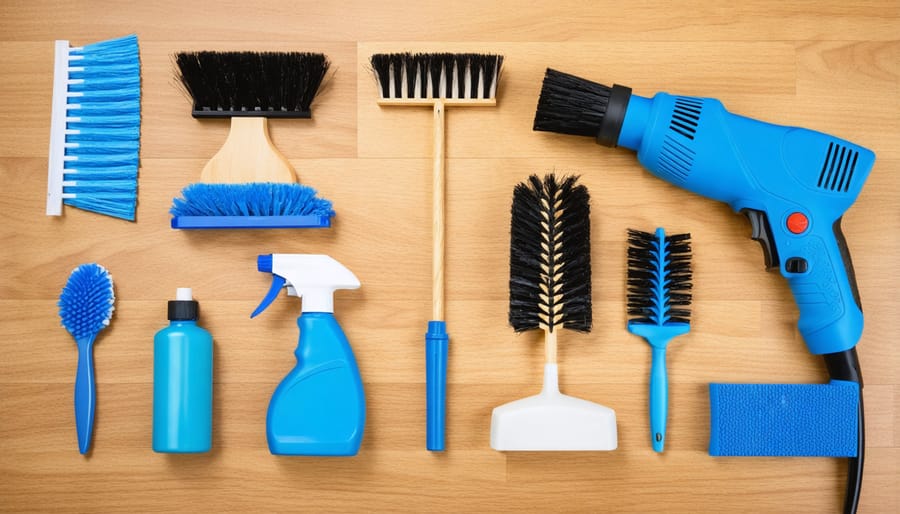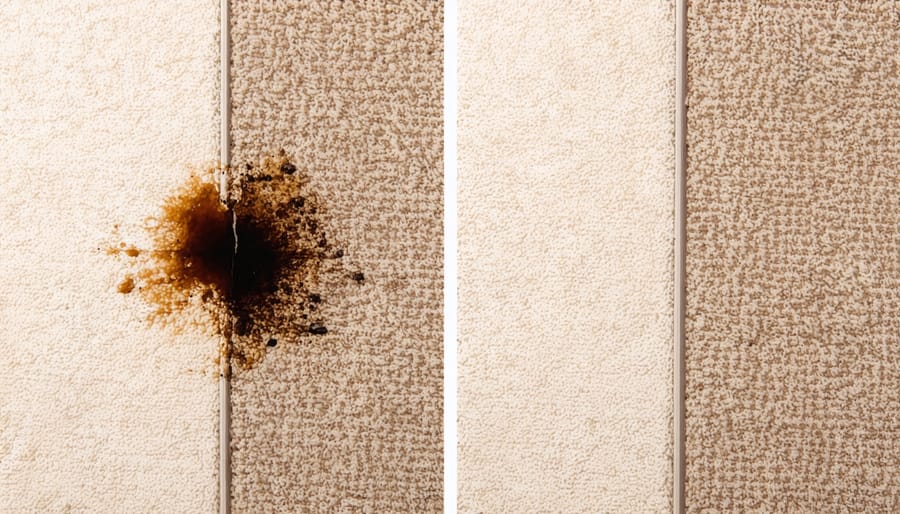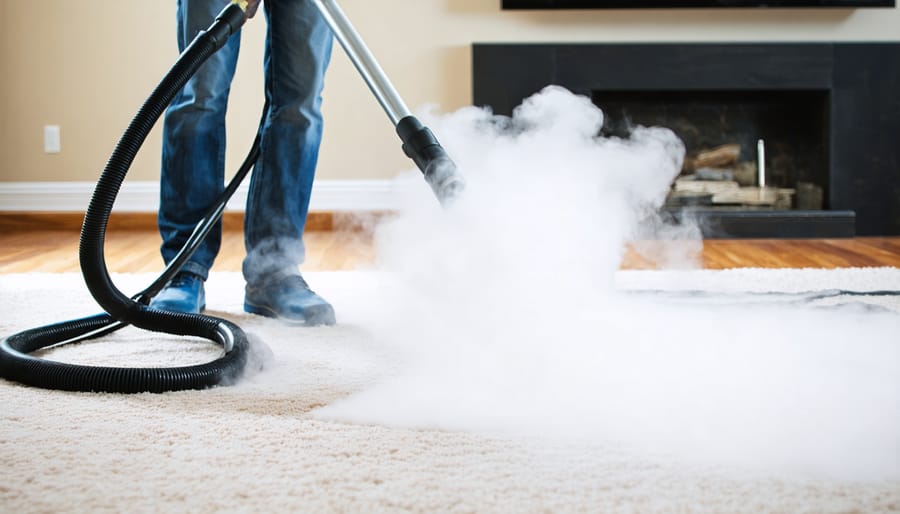Transform your carpets from dingy to dazzling with proven best carpet cleaning methods that restore their original beauty right at home. Deep-clean stubborn stains by combining equal parts white vinegar and warm water in a spray bottle, blotting gently with a clean microfiber cloth, and allowing the area to air dry completely. Remove embedded dirt and refresh carpet fibers by sprinkling baking soda across the entire surface, letting it sit for at least 30 minutes, then vacuuming thoroughly with overlapping strokes. For weekly maintenance, vacuum in multiple directions using slow, deliberate passes to extract dirt from deep within the carpet pile, focusing extra attention on high-traffic areas and entry points.
Regular carpet cleaning not only extends your flooring’s lifespan but also improves indoor air quality and creates a healthier living environment for your family. Whether dealing with sudden spills or tackling years of accumulated grime, these proven techniques help maintain your carpet’s appearance and integrity without the expense of professional services. Learn these essential methods to keep your carpets looking fresh and vibrant year-round.
Essential Tools and Products for DIY Carpet Cleaning

Basic Cleaning Supplies
Getting started with carpet cleaning doesn’t require fancy equipment. Most of what you need is probably already in your home! For basic carpet cleaning tasks, gather these essential supplies:
A vacuum cleaner with strong suction is your first line of defense. Make sure it’s well-maintained with clean filters for optimal performance. You’ll also need white cloths or paper towels for blotting stains, and a spray bottle for mixing cleaning solutions.
For cleaning solutions, keep these household staples handy:
– White vinegar (great for natural cleaning)
– Baking soda (excellent for deodorizing)
– Mild dish soap (perfect for gentle cleaning)
– Clean, cool water
– Salt (for absorbing fresh stains)
Additional helpful tools include:
– Soft-bristled brush or sponge
– Plastic scraper or old credit card
– Clean bucket
– Rubber gloves
For deeper cleaning sessions, consider adding:
– Cornstarch (for grease stains)
– Hydrogen peroxide (for tough stains)
– Essential oils (for natural fragrance)
Store these supplies together in a dedicated cleaning caddy for quick access when spills happen. Remember to always test any cleaning solution on a small, hidden area first to ensure it won’t damage your carpet.
Equipment Options
When it comes to cleaning your carpets at home, having the right equipment makes all the difference. You’ll find several options to suit different needs and budgets. For quick spot cleaning, a handheld carpet spot cleaner is perfect for tackling small stains and spills. These compact machines are easy to store and ready to use at a moment’s notice.
For whole-room cleaning, consider investing in an upright carpet cleaner. These machines typically feature rotating brushes, a clean water tank, and a dirty water collection tank. They work similarly to professional equipment but are designed for home use. Many models come with useful attachments for stairs and upholstery.
Steam cleaners offer another effective option, using hot water vapor to deep clean and sanitize carpet fibers. For those preferring a manual approach, carpet cleaning brushes with varying bristle strengths work well with cleaning solutions for spot treatment and general maintenance.
Don’t forget about vacuum cleaners – they’re essential for regular carpet care. Look for models with HEPA filters and adjustable height settings for different carpet piles. Some also come with specialized pet hair attachments, perfect for homes with furry friends.
Quick-Fix Spot Cleaning Techniques
Fresh Stain Treatment
When it comes to fresh stains, quick action is your best ally. Start by blotting the spill with clean white paper towels or cloth – never rub, as this can work the stain deeper into the fibers. Work from the outer edges toward the center to prevent spreading.
For water-soluble stains like coffee, wine, or juice, mix one tablespoon of dish soap with two cups of cool water. Using a clean white cloth, gently dab the solution onto the stain, then blot with a dry cloth to absorb the moisture. Repeat until the stain lifts.
For tougher spills like grease or oil, sprinkle baking soda or cornstarch over the area and let it sit for 15-20 minutes. The powder will help absorb the stain before you vacuum it up. Follow with the soap solution if needed.
Remember these key tips:
– Always test cleaning solutions on a hidden spot first
– Don’t oversaturate the carpet
– Use white cloths to avoid color transfer
– Keep blotting until no more color transfers to your cloth
– Allow the area to dry completely before walking on it
For pet accidents, use an enzymatic cleaner specifically designed for biological stains to prevent lingering odors.

Set-In Stain Solutions
Don’t let those stubborn, set-in stains make you lose hope! While fresh stains are easier to tackle, there are effective methods for handling those older, more challenging spots on your carpet. Start by mixing one part white vinegar with one part warm water and add a tablespoon of dish soap. Gently blot the stain with this solution using a clean white cloth, working from the outer edges toward the center to prevent spreading.
For particularly tough stains, create a paste using baking soda and water. Apply it to the stained area, let it dry completely (usually 4-6 hours), then vacuum thoroughly. If you’re dealing with old oil-based stains, sprinkle cornstarch or baking soda over the area, let it sit for 15-20 minutes to absorb the oils, then vacuum.
For those really challenging spots, try a mixture of hydrogen peroxide and dish soap (2:1 ratio), but always test this solution on an inconspicuous area first, as it may lighten some carpet fibers. Apply the mixture sparingly, let it sit for 10 minutes, then blot with a clean, damp cloth.
Remember, patience is key with set-in stains. You might need to repeat these treatments several times before seeing significant improvement.
Deep Cleaning Methods

Steam Cleaning at Home
Steam cleaning is one of the most effective steam cleaning techniques for deep-cleaning your carpets at home. Here’s how to do it properly:
Start by thoroughly vacuuming the entire carpet to remove loose dirt and debris. Fill your steam cleaner’s water tank with hot water and add the appropriate cleaning solution according to the manufacturer’s instructions. Avoid using too much detergent, as this can leave residue in your carpet.
Begin cleaning in the farthest corner of the room and work your way toward the exit. Make slow, overlapping passes with the steam cleaner, pulling it backward rather than pushing forward. This ensures better dirt extraction and prevents over-wetting the carpet.
For heavily soiled areas, make multiple passes while the carpet is still damp. After completing a section, go over it again using just the suction feature to remove excess moisture. This helps prevent mold and mildew growth.
Allow the carpet to dry completely before walking on it or replacing furniture. Speed up drying by opening windows, running fans, or using your AC. Most carpets take 6-10 hours to dry fully, though this varies based on humidity and carpet thickness.
Remember to empty and clean your steam cleaner after use to maintain its effectiveness and prevent unpleasant odors.
Dry Cleaning Methods
Dry cleaning methods offer an excellent alternative for those who want to avoid excessive moisture in their carpets or need a quick cleaning solution. These methods typically use specialized compounds that absorb dirt and can be easily vacuumed away.
Start by thoroughly vacuuming the carpet to remove loose debris. Then, sprinkle a commercial dry cleaning compound evenly across the carpet surface. These compounds usually look like fine, slightly dampened sawdust and contain detergents, solvents, and a small amount of moisture to help lift dirt.
Using a soft-bristled brush, work the compound gently into the carpet fibers in a circular motion. This action helps the cleaning agents bind with dirt and stains. Let the compound sit for 15-30 minutes, allowing it to fully absorb the dirt from your carpet.
For best results, divide your carpet into manageable sections and work methodically. Pay extra attention to high-traffic areas and visible stains, where you might need to apply more compound and brush more thoroughly.
Once the waiting time is up, vacuum the area thoroughly, making several passes to remove all the cleaning compound along with the absorbed dirt. You might need to vacuum twice to ensure all residue is gone.
This method is particularly suitable for delicate carpets, quick touch-ups before guests arrive, or situations where you need the carpet to be ready for use quickly. Plus, it’s virtually mess-free and doesn’t risk over-wetting your carpet or padding.
Natural Cleaning Solutions
For those seeking eco-friendly alternatives to commercial cleaners, natural cleaning solutions can be just as effective while being safer for your family and the environment. One of the most versatile combinations is a mixture of white vinegar and warm water (1:3 ratio), which helps neutralize odors and lift light stains. For deeper cleaning, create a paste using baking soda and water, which works wonderfully on stubborn spots – simply apply, let it sit for 15 minutes, and vacuum thoroughly.
Another powerful natural option is club soda, which works especially well on fresh spills. Pour it directly onto the stain, blot (never rub!) with a clean white cloth, and repeat if necessary. For deodorizing, sprinkle dried herbs like rosemary or lavender mixed with baking soda across your carpet, let it sit for an hour, then vacuum.
Essential oils can add both cleaning power and pleasant scents to your natural solutions. Try adding 10-15 drops of tea tree oil to your vinegar mixture for its antimicrobial properties, or use lavender oil for its fresh scent and natural antibacterial qualities. Remember to always test any cleaning solution on an inconspicuous area first, even natural ones, to ensure it won’t affect your carpet’s color or texture.
Preventive Maintenance Tips
Daily Care Routine
A consistent daily care routine is your first line of defense against carpet wear and tear. Start by implementing a strict “no shoes” policy indoors – this simple habit can reduce up to 80% of tracked-in dirt. Keep doormats at all entrances, and vacuum high-traffic areas daily using slow, overlapping strokes.
For the best results, follow these professional carpet maintenance tips daily: address spills immediately by blotting (never rubbing) with a clean white cloth, rotate furniture monthly to prevent permanent indentations, and keep a spot-cleaning solution handy for unexpected accidents.
Consider using carpet protectors under furniture legs and establishing designated eating areas to minimize food-related stains. Invest in a quality vacuum with HEPA filtration, and empty the canister or bag when it’s half full to maintain optimal suction. Remember to brush your pets regularly outdoors to reduce fur accumulation on carpets.
These simple daily practices will significantly extend your carpet’s life and maintain its appearance between deep cleaning sessions.
Protective Measures
Prevention is always better than cure when it comes to carpet care. Start by placing doormats at all entrances and establishing a “no shoes” policy indoors to minimize dirt tracking. Consider using clear plastic runners in high-traffic areas, especially during wet weather or when hosting gatherings.
Treat spills immediately by blotting (never rubbing) with clean, white cloths. Keep a spot-cleaning kit handy with white vinegar, baking soda, and mild dish soap for quick response to accidents. Apply fabric protector spray to your carpets every 6-12 months after deep cleaning to create an invisible barrier against stains.
Vacuum at least twice weekly, focusing on high-traffic areas, to prevent dirt from settling deep into carpet fibers. For homes with pets, daily vacuuming might be necessary. Remember to adjust your vacuum’s height setting according to your carpet’s pile length for optimal cleaning.
Create designated eating areas away from carpeted spaces to minimize food-related stains. Use furniture pads under heavy pieces to prevent carpet crushing and consider rotating furniture periodically to ensure even wear. Regular professional cleaning every 12-18 months will help maintain your carpet’s protective treatments and extend its lifespan.
Maintaining clean carpets doesn’t have to be a daunting task when you have the right tools and knowledge at your disposal. As we’ve explored throughout this guide, regular carpet cleaning is essential not only for aesthetics but also for creating a healthier living environment for you and your family.
Remember that the key to successful carpet maintenance lies in a three-pronged approach: prevention, regular cleaning, and prompt attention to spills and stains. By implementing a no-shoes policy, using doormats effectively, and vacuuming at least twice a week, you can significantly reduce the amount of dirt and debris that settles into your carpet fibers.
Whether you choose steam cleaning, dry cleaning, or spot treatment methods, the most important factor is consistency. Set up a regular cleaning schedule that works for your lifestyle, and don’t wait until your carpets look visibly dirty before taking action. Small, regular efforts will always be more effective than occasional deep cleanings.
Keep your cleaning supplies well-stocked and easily accessible for quick response to accidents. And while these DIY methods are highly effective, don’t hesitate to call in professional help for annual deep cleaning or particularly stubborn stains.
By following these maintenance tips and cleaning techniques, you can extend the life of your carpets while keeping them fresh, clean, and inviting for years to come. Your carpets are an investment in your home’s comfort and appearance – treat them with care, and they’ll reward you with lasting beauty and durability.
